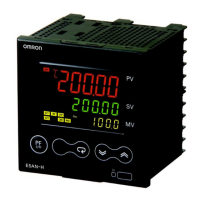88
Shifting Input Values Section 4-1
Two-point shift
• Separate shift values can be set for the upper limit and lower limit of the
sensor input range for an infrared sensor as well as for a thermocouple or
platinum resistance thermometer with the Input Shift Type parameter set
to INS2. If different shift values are set for the upper limit and lower limit,
then the slope of the line will be different before and after applying the
input shift. For example, if the upper-limit value is set to 2°C and the
lower-limit value is set to 1°C, the input temperature will be shifted by
1.5°C for a 50% input, i.e., by the average of the upper-limit and lower-
limit values.
• Set the upper-limit value in the Upper-limit Temperature Input Shift Value
parameter and the lower-limit value in the Lower-limit Temperature Input
Shift Value parameter.
4-1-2 How to Calculate Input Shift Values for a 2-point Shift
Offset the readout value using a 1-point or 2-point shift as described in this
section. This offset occurs because a bias current for detecting a Controller
sensor error flows to the output impedance of the infrared temperature sen-
sor.
Method for a 1-point Shift
1,2,3... 1. In the configuration shown in Figure 1, bring the set point to near the value
at which the temperature of the control target is to be controlled. Assume
that the control target temperature (C) and the thermometer temperature
(B) are the same.
2. Check the control target temperature (B) and the Controller readout (A).
Subtract the Controller readout temperature (A) from the control target
temperature (B), and set ins as the input shift value to the result. The shift
is illustrated in Figure 2.
insh
insl
Upper-limit
Temperature
Input Shift Value
Lower-limit
Temperature
Input Shift Value
0
100
Temperature
Upper limit
Lower limit
Before shifting
After shifting
Input
Upper-limit temperature
input shift value
Lower-limit temperature
input shift value
C
ins
1.00

